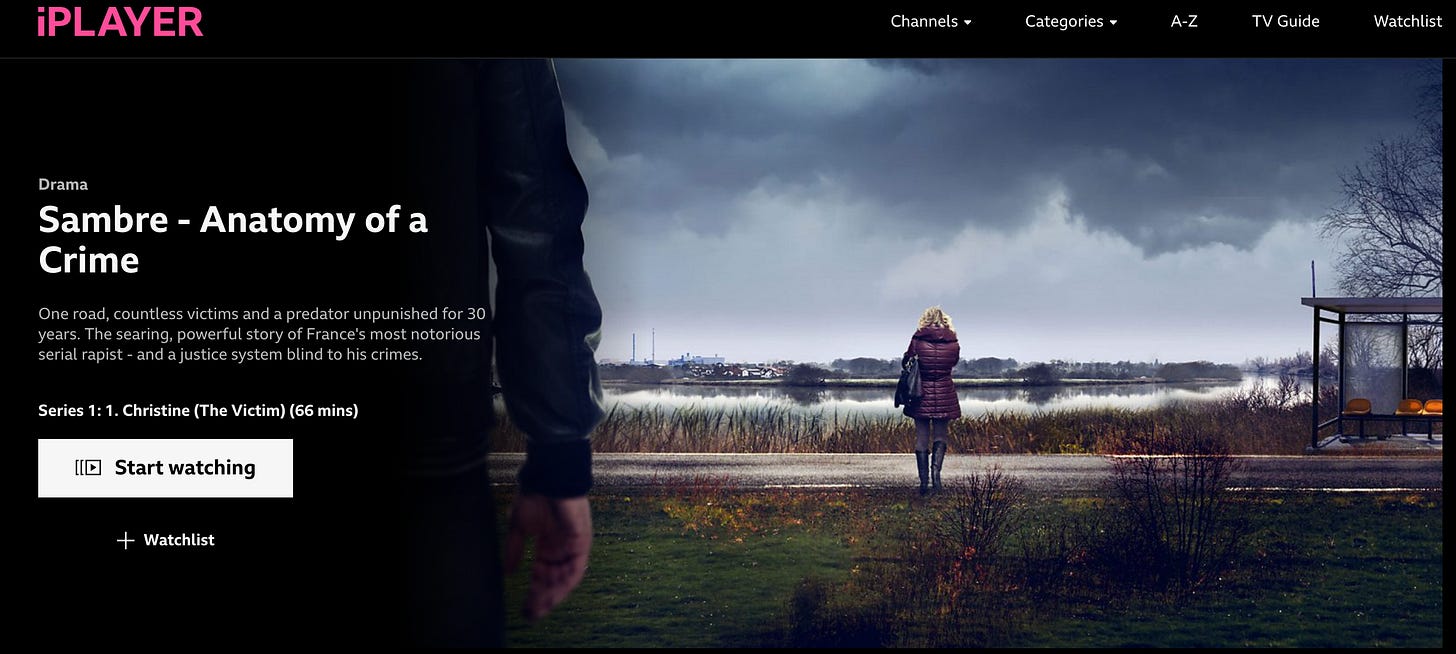Sambre – a shocking case
This French TV drama shows how police apathy allowed a serial predator to terrorise women living along the Sambre river for decades
How does a factory worker get away with a devastating series of sexual attacks for 30 years?
In an area with a relatively low population?
Would he have to be a criminal mastermind, with a fiendish ability to outwit all the agencies of law enforcement? Would he need to have extraordinary luck to evade the best minds in the police time and again? And again?
No, it turns out he would only need toxic levels of indifference from the local cops and politicians to wreck the lives of many local women with near impunity.
I’ve just watched a powerful, engrossing French drama on BBC iPlayer (in the UK) – Sambre – Anatomy of a Crime. It’s a fictionalised depiction of a scandalous one-man crime spree that took place between 1988 and 2018.
A predator in plain sight
More than 50 women and minors were sexually assaulted by one man during these years. He was not a sinister recluse living along, but a well-known and garrulous member of the community.
He was a buddy of local police officers, he coached the kids’ football team.
This six-part drama is sombre, each episode telling the story of one crucial figure in the unfolding tragedy – a victim, judge, mayor, scientist, detective and, finally, the perpetrator.
Here he is Enzo Salina, a fictionalised version of real attacker Dino Scala, convicted in 2022 for multiple sexual assaults.
Many factors have been attributed to explaining the catastrophic failure to catch Scala – lack of coordination between jurisdictions along the Sambre river in northern France and Belgium, where he operated; blindness of police in recognising patterns in the attacks and failure to link them; delays in utilising DNA evidence; unwillingness to believe witness testimony from victims.
But the drama focuses very much on the institutional indifference to taking the crimes seriously.
A victim is asked if she actually wants to report her attack
In episode one, a senior cop explains to a new recruit that their sleepy town is a cushy job for police, with just the odd barroom brawl to sort out. When victims turn up to report their ordeal at the hands of the rapist, the cops struggle to even go through the motions of recording the crime properly.
They downgrade the report of the first victim we see, Christine, to ‘attempted robbery with assault’.
The cops want to keep paperwork to a minimum, they are insensitive, make jokes. One victim is asked if she actually wants to make a report, as if she just popped into the station to chat about the pain and humiliation she’s suffered with a bunch of strangers. ‘Are you serious?’ she asks.
A politician says you never know who to believe when dealing with such cases. Best leave it alone.
A female mayor, on discovering that police have never alerted locals to the ongoing wave of sexual attacks taking place, is horrified and says it is her duty to warn her constituents.
The police resist this, claiming it might jeopardise their ‘investigation’. Her brilliant response is, You just said you have no leads, so there is nothing to jeopardise.
We never lose sight of the victims in this series, whose struggles to cope with what has happened to them is recounted down the decades.
Perhaps the most devastating episode concerns the scientist, or geographic profiler. She actually builds a convincing profile of the rapist and his likely whereabouts – one that challenges the official inaccurate presumptions.
But ultimately, it is the dead hand of bureaucracy that once again buries this valuable intel and effectively assists the rapist.
If you can find Sambre – Anatomy of a Crime on a streaming platform near you, I would recommend it. It may make you want to scream at the TV, but it is also a powerful tribute to the humanity of the women depicted.
It also makes a strong case for police accountability in their communities.




Thank you for this review! It is really interesting to see how media depicts crime in either true crime or fictionalized form. We think that both can provide really interesting ways to think about what the society in which these were produced.
In this tragic case, as you suggest, the show seems to point to potential real problems.